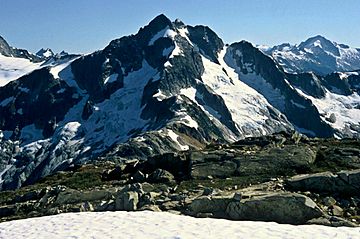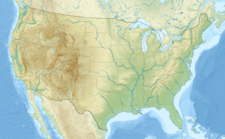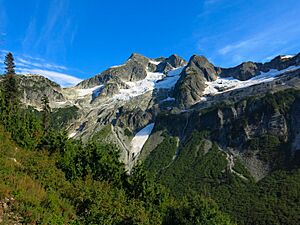Whatcom Peak facts for kids
Quick facts for kids Whatcom Peak |
|
|---|---|

North aspect
|
|
| Highest point | |
| Elevation | 7,574 ft (2,309 m) |
| Prominence | 1,294 ft (394 m) |
| Geography | |
| Parent range | Cascade Range |
| Topo map | USGS Mount Challenger |
| Climbing | |
| First ascent | 1936 Fred Berry, Lawrence Buchanen |
Whatcom Peak is a tall mountain in North Cascades National Park in the U.S. state of Washington. It stands about 7,574 feet (2,308 meters) high.
Whatcom Peak is located near the Challenger Glacier. The Whatcom Glacier flows down from its northeast side. Another unnamed glacier hangs on the peak's northwest slope. This mountain is found between Mount Challenger and Easy Peak.
Mountain Weather
Whatcom Peak is in a special climate zone called the marine west coast climate. This means it's near the ocean and gets a lot of moisture. Most of the weather systems come from the Pacific Ocean. They travel east towards the Cascade Range.
When these weather systems reach the North Cascades, the mountains force the air to rise. This is called orographic lift. As the air goes up, it cools down and drops its moisture. This causes a lot of rain or snowfall on the mountains, especially in winter.
Because of the ocean's influence, the weather here is usually mild. Temperatures rarely go below 0°F (–18°C) or above 80°F (27°C). Winters are often cloudy, but summers usually have clear skies. The snow here tends to be wet and heavy. This can sometimes lead to avalanches, where large amounts of snow slide down the mountain.
How the Mountains Formed
The North Cascades area has very rugged land. You can see sharp peaks, tall spires, long ridges, and deep valleys carved by glaciers. These amazing shapes were created by geological events that happened millions of years ago.
The Cascade Mountains started forming a very long time ago, during the late Eocene Epoch. This was when the North American Plate slowly moved over the Pacific Plate. This movement caused a lot of volcanic activity, creating many rocks from melted earth. Also, small pieces of the Earth's crust, called terranes, came together to form the North Cascades about 50 million years ago.
Later, during the Pleistocene period (which was over two million years ago), huge sheets of ice called glaciers moved across the land many times. As they moved, they scraped and shaped the landscape. They left behind piles of rock and debris. The "U"-shaped valleys you see today were carved out by these glaciers. The combination of the land pushing up (uplift) and cracks forming in the Earth's crust (faulting), along with the glaciers, created the tall peaks and deep valleys of the North Cascades.




